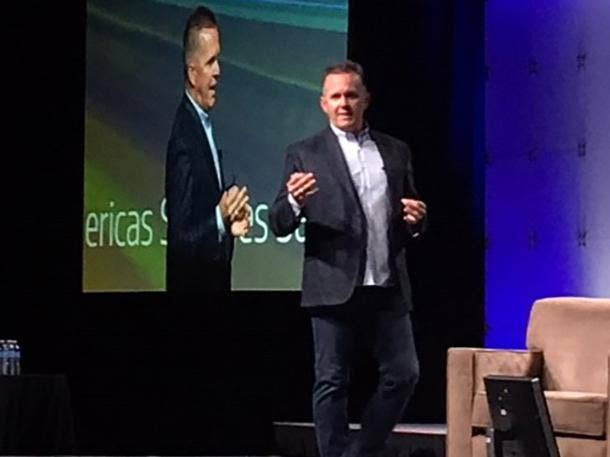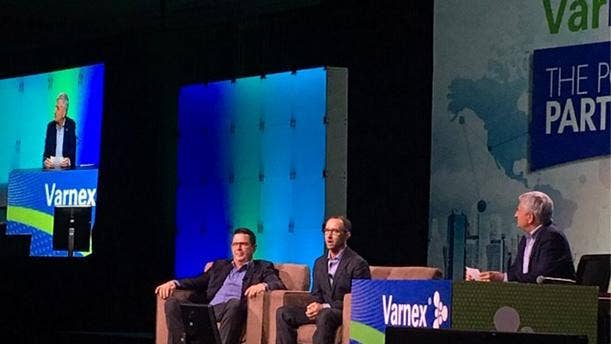From Security To SaaS: HP, Lexmark Pitch Their Printer Strategies

HP Inc. and Lexmark took to the stage Thursday morning in an attempt to convince solution providers that their printer and related services strategies are right for the channel.
The pitches from the two vendors were presented during the Synnex Varnex 2018 conference held this week in Desert Springs, Calif.
While David Lary, vice president of HP’s Americas supply sales, and Sammy Kinlaw, Lexmark’s vice president of worldwide channel and OEM sales, in their separate presentations weren't actually dueling with each other, they were presenting visions aimed at attracting solution providers to their offerings.
[Related: A Look Ahead: What's Next For Printers]
Lary (pictured in photo above) told solution providers that Palo Alto, Calif.-based HP's personal systems business grew 12 percent and its printer business grew 11 percent year-over-year in the third quarter. That included eight straight quarters of double-digit growth in personal systems, and a 12-percent increase in the number of printers sold.
"We are innovating," he said. "We are doing new things. We are more agile."
HP saw an overall year-over-year increase in sales through Fremont, Calif-based distributor Synnex of 27 percent in the third quarter, including a 19-percent growth in PC sales, a 62-percent in A3 printer revenue, and a 14-percent rise in supply sales, Lary said.
"HP is a channel company," he said. "Eighty-seven percent of what we do is through the channel. You guys get a cold? We feel it."
Security is a big part of HP's message as 71 percent of security breaches start at endpoints including PCs and printers, Lary said.
"You're effectively selling security," he said. "HP has invested tons in protecting the devices."
HP has also invested heavily in moving towards device-as-a-service, where devices like PCs and printers are paid for not as a capital expense but based on actual usage, Lary said.
The company is also encouraging solution providers to make managed print services a bigger part of its business given that the industry is already seeing over 50 percent of all print supplies being sold on-line, including 55 percent of all toner and 33 percent of all ink, he said.
Lary also told solution providers to start working with HP for 3D printing, which today is still focused on prototyping and manufacturing but will see more use cases going forward. "There's a $12-billion TAM (total addressable market) we want to disrupt," he said.
Overall, HP now has its biggest portfolio ever thanks in part to the focus on its core markets it could have after HP Inc. and Hewlett Packard Enterprise in 2015 separated from the original HP. "It's important that we separated from the greater HP," he said.
Kinlaw (center in photo, with Lexmark's Greg Chavers on left and Synnex's Bob Stegner on right), who early this year left Lenovo to join Lexington, Ky.-based Lexmark, told solution providers he made the move because he felt an opportunity to help grow a company with a strong brand and product line to new levels.

Lexmark's Sammy Kinlaw (center) with Greg Chavers (left) and Synnex's Bob Stegner
Kinlaw said that when he left Lenovo, the company's channels had grown for 26 consecutive quarters, and that he felt it was time to take his experience to Lexmark. "I saw in a very short order that I could institute changes that make a difference," he said.
Lexmark in 2018 was focused on transactional changes, and saw 90-plus-percent of its overall revenue come from the channel, Kinlaw said. "To maintain double-digit growth, you have to think differently," he said.
For 2019, Lexmark's top executive have spelled out four major growth focuses, including driving the company's brand, make all its products channel-specific, change its market coverage market to focus on channels, and become better aligned to more specific verticals.
Lexmark is moving into the small and midsize printer business at a dramatic clip and shifting its focus from the enterprise and larger deals, Kinlaw said. "We didn't have the right coverage model," he said.
For 2019, Lenovo's focus on SMB sales will be led by Greg Chavers, vice president of North America channel sales, who will have a very large team working with partners, Kinlaw said. "So when you call on an SMB, call on Lexmark," he said.
Lexmark in 2019 will also focus on developing new vertical focuses including software-as-a-service, he said.
Lexmark last month designated its Go line of printers as its line of partner-led products with improved margins, spifs, and other benefits, Kinlaw said. "This is going to be a mainstay, and one of the biggest growth opportunities in 2019," he said.
For Philippe Beaudoin, director of sales and corporate development at Megaburo, a Thetford Mines, Quebec-based printer solution provider and copier dealer, the presentations by HP and Lexmark were a chance to see what his company needs to do to grow its business.
Megaburo is a Canon copier dealer and offers managed copier services, but is seeing a drop in the copier business even as the print business is growing, leading Beaudoin and his team to look at how to move its business to more of a printer focus, especially managed print services, he told CRN.
"We've been talking about this for a long time," he said. "But it's really happening."
A big problem with trying to shift business is that sales reps make more money selling copiers while seeing low margins on printers combined with better margins on printer services and supplies, Beaudoin said.
He said his company is looking at how to leverage Synnex's relationships with HP and Lexmark to support his company's efforts to shift its focus.
"If we don't have the expertise, we can't tell customers that we don't," he said. "They will go to where they can get what they need. With Synnex, we can get the expertise we need, and let us advertise to our customers that we do have the expertise they need."